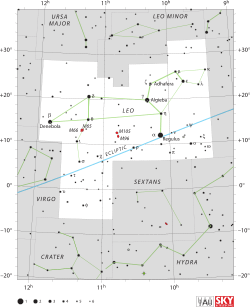Rho Leonis

Location of ρ Leonis (circled) | |
| Observation data Epoch J2000 Equinox J2000 | |
|---|---|
| Constellation | Leo |
| Right ascension | 10h 32m 48.67168s[1] |
| Declination | +09° 18′ 23.7094″[1] |
| Apparent magnitude (V) | 3.856[2] |
| Characteristics | |
| Spectral type | B1 Iab[3] |
| U−B color index | –0.945[2] |
| B−V color index | –0.153[2] |
| Variable type | –6.8[4] |
| Astrometry | |
| Radial velocity (Rv) | +42.0[5] km/s |
| Proper motion (μ) | RA: –5.57[6] mas/yr Dec.: –3.59[6] mas/yr |
| Parallax (π) | 0.60 ± 0.18[6] mas |
| Distance | approx. 5,000 ly (approx. 1,700 pc) |
| Details | |
| Mass | 27.1 ± 8.4[7] M☉ |
| Radius | 37.4[8] R☉ |
| Luminosity | 295,000[4] L☉ |
| Surface gravity (log g) | 3.09[9] cgs |
| Temperature | 24,200[9] K |
| Metallicity [Fe/H] | –0.89[9] dex |
| Rotation | 7 ± 2 days[10] |
| Rotational velocity (v sin i) | 60[11] km/s |
| Age | 4.5 ± 0.1[7] Myr |
| Other designations | |
Rho Leonis (ρ Leo) is a binary star in the zodiac constellation of Leo, and, like the prominent nearby star Regulus, it is located near the ecliptic. With an apparent visual magnitude of 3.9,[2] this star can be readily seen with the naked eye at night. Parallax measurements give a distance estimate of about 5,400 light-years (1,700 parsecs) from the Earth.[6]
This is an enormous star with about 21 times the Sun's mass[13] and 37 times the Sun's radius.[8] Its spectrum matches a stellar classification of B1 Iab,[3] with the 'Iab' luminosity class indicating that it is in the supergiant stage of its evolution. Rho Leonis is radiating about 295,000 times the Sun's luminosity[4] at an effective temperature of 24,200 K,[9] giving it the blue-white hue typical of a B-type star. A strong stellar wind is expelling mass from the outer envelope at a rate of 3.5 × 10–7 times the Sun's mass per year, or the equivalent of a solar mass every 2.8 million years.[8] The rotation rate is probably about once per 7 days, with an upper limit of 47 days.[10]
Rho Leonis is classified as a runaway star, which means it has a peculiar velocity of at least 30 km s–1 relative to the surrounding stars. It has radial velocity of 42 km s–1 away from the Sun and a proper motion that is carrying it about 1.56 Astronomical Units per year, equivalent to 7 km s–1,[14] in a transverse direction. The star is situated about 2,300 light-years (710 parsecs) above the galactic plane.[15]
This is a binary star system with a magnitude 4.8 companion at an angular separation of 0.11 arcseconds.[16]
References
- ↑ 1.0 1.1 van Leeuwen, F. (November 2007), "Validation of the new Hipparcos reduction", Astronomy and Astrophysics 474 (2): 653–664, arXiv:0708.1752, Bibcode:2007A&A...474..653V, doi:10.1051/0004-6361:20078357
- ↑ 2.0 2.1 2.2 2.3 Gutierrez-Moreno, Adelina et al. (1966), A System of photometric standards 1, Publicaciones Universidad de Chile, Department de Astronomy, pp. 1–17, Bibcode:1966PDAUC...1....1G
- ↑ 3.0 3.1 Lesh, Janet Rountree (December 1968), "The Kinematics of the Gould Belt: an Expanding Group?", Astrophysical Journal Supplement 17: 371, Bibcode:1968ApJS...17..371L, doi:10.1086/190179
- ↑ 4.0 4.1 4.2 Crowther, P. A.; Lennon, D. J.; Walborn, N. R. (January 2006), "Physical parameters and wind properties of galactic early B supergiants", Astronomy and Astrophysics 446 (1): 279–293, arXiv:astro-ph/0509436, Bibcode:2006A&A...446..279C, doi:10.1051/0004-6361:20053685
- ↑ Wilson, Ralph Elmer (1953), General Catalogue of Stellar Radial Velocities, Washington: Carnegie Institution of Washington, Bibcode:[http://adsabs.harvard.edu/abs/1953QB901.W495..... 1953QB901.W495.....]
- ↑ 6.0 6.1 6.2 6.3 Perryman, M. A. C.; et al. (July 1997), "The HIPPARCOS Catalogue", Astronomy & Astrophysics 323: L49–L52, Bibcode:1997A&A...323L..49P
- ↑ 7.0 7.1 Tetzlaff, N.; Neuhäuser, R.; Hohle, M. M. (January 2011), "A catalogue of young runaway Hipparcos stars within 3 kpc from the Sun", Monthly Notices of the Royal Astronomical Society 410 (1): 190–200, arXiv:1007.4883, Bibcode:2011MNRAS.410..190T, doi:10.1111/j.1365-2966.2010.17434.x
- ↑ 8.0 8.1 8.2 Kraus, M.; Borges Fernandes, M.; Kubát, J. (May 2009), "Parameters of galactic early B supergiants. The influence of the wind on the interstellar extinction determination", Astronomy and Astrophysics 499 (1): 291–299, Bibcode:2009A&A...499..291K, doi:10.1051/0004-6361/200810319
- ↑ 9.0 9.1 9.2 9.3 Gies, Douglas R.; Lambert, David L. (March 10, 1992), "Carbon, nitrogen, and oxygen abundances in early B-type stars", Astrophysical Journal, Part 1 387: 673–700, Bibcode:1992ApJ...387..673G, doi:10.1086/171116
- ↑ 10.0 10.1 Kholtygin, A. F. et al. (November 2007), "Microvariability of line profiles in the spectra of OB stars: III. The supergiant ρ LEO", Astronomy Reports 51 (11): 920–931, Bibcode:2007ARep...51..920K, doi:10.1134/S1063772907110054
- ↑ Bernacca, P. L.; Perinotto, M. (1970), "A catalogue of stellar rotational velocities", Contributi Osservatorio Astronomico di Padova in Asiago 239 (1), Bibcode:1970CoAsi.239....1B
- ↑ "V* rho Leo -- Variable Star", SIMBAD (Centre de Données astronomiques de Strasbourg), retrieved 2010-06-11
- ↑ Conlon, E. S. et al. (September 1990), "The runaway nature of distant early-type stars in the galactic halo", Astronomy and Astrophysics 236 (2): 357–361, Bibcode:1990A&A...236..357C
- ↑ An Astronomical Unit (AU) is 1.5 × 108 km, while a year is 3.2 × 107 seconds. Thus, 1.56 AU/year = (1.56 AU/yr) × (1.5 × 108 km/AU) / (3.2 × 107 s/yr) = 7 km/s.
- ↑ Lauroesch, J. T.; Meyer, David M. (July 2003), "Variable Na I Absorption toward ρ Leonis: Biased Neutral Formation in the Diffuse Interstellar Medium?", The Astrophysical Journal 591 (2): L123–L126, arXiv:astro-ph/0306005, Bibcode:2003ApJ...591L.123L, doi:10.1086/377164
- ↑ Eggleton, P. P.; Tokovinin, A. A. (September 2008), "A catalogue of multiplicity among bright stellar systems", Monthly Notices of the Royal Astronomical Society 389 (2): 869–879, arXiv:0806.2878, Bibcode:2008MNRAS.389..869E, doi:10.1111/j.1365-2966.2008.13596.x
External links
- Kaler, James B., "Rho Leonis", Stars (University of Illinois), retrieved 2012-01-11
| ||||||||||||||||||||||||||